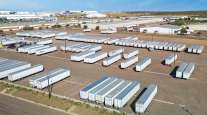Senior Reporter
Trailer Orders Hit Year-End Slump; Backlog for 2020 Slides Lower

[Stay on top of transportation news: Get TTNews in your inbox.]
Net U.S. trailer orders in December fell to just below 18,000, ACT Research reported. It was the lowest level of the fourth quarter in a year that saw overall orders fall 51% compared with 2018, the strongest year on record.
Orders in the month hit 17,691 compared with 27,800 a year earlier, according to ACT. That leaves the backlog at 5.2 months heading into 2020.
Full-year orders plunged to 205,365. That was down from 2018’s record total of 420,000.
ACT Research: U.S. Trailer Net Orders Closed 2019 Down 51% vs Full-Year 2018https://t.co/3l07zGF6Bi — ACT Research (@actresearch) January 21, 2020
“Fleets are ordering at a pace that continues to be below the overall build rates,” Frank Maly, director of commercial vehicle transportation analysis at ACT, told Transport Topics.
Another concern of his is the industry has exited a time when most of the trailers built had homes.
“They weren’t speculative orders; fleets came and picked them up and used them,” he said.
New US trailer orders of 18.4k were down 13% month-over-month in December, and after accounting for cancellations, net orders of 17.7k dropped 11%. #Trailers #Transportation #truck #trucking #semitruck #freight https://t.co/geTZuFG28s pic.twitter.com/8jWCPZZkJM — ACT Research (@actresearch) January 22, 2020
Now it appears that pattern may have swung a bit and there are trailers in the overall system, both factory and dealer, that are more stock in terms of features.
“For a lot of larger fleets, those aren’t necessarily the kinds of trailers they want to acquire because they have their own way they like to spec’ things so they keep it consistent,” Maly said.

Maly
Stock trailers typically are built for smaller or medium-size fleets to put into operation, he added, and those are the carriers that are being challenged most financially, particularly because of the decline in spot rates.
“If that’s the target market for these trailers, it makes it tough to move these out of the system and onto the road,” Maly said.
The Chainalytics-Cowen Freight Indices for the week of Jan. 21 showed year-over-year spot rates were lower for all three trailer types — dry van, refrigerated and intermodal, down 1.4%, 4.5% and 5%, respectively.
One carrier executive saw recently a “surprising” decline in the number of carriers, and that has led to a tighter market.
“I will say the available carriers went down considerably in both December and in the first couple of weeks here in January,” Shelley Simpson, president of highway services for J.B. Hunt Transport Services Inc., said during the carrier’s latest earnings call. “That was a surprise even from normal seasonality. So for us, it’s too early to call on what that means in the market. Certainly, it feels, from a supply side, like a tighter environment than really what people are talking about.”

Simpson
J.B. Hunt Transport Services ranks No. 4 on the Transport Topics Top 100 list of the largest for-hire carriers in North America. It also ranks No. 4 on the Transport Topics Top 50 list of the largest logistics companies in North America.
One manufacturer reported the trailer business remains challenging, as it has been for months, but this downward pressure in 2019 is to be expected after the strength in 2018, and the 10th consecutive year of an up cycle.
“Demand is down, but is better now that we are in January, and hopefully with the trade deals both being signed, it will continue to pick up,” said Craig Bennett, senior vice president of sales for Utility Manufacturing Co. “[Last year] was an all-time record for Utility in terms of trailers produced.”
As for material prices, they seem to have stabilized, but time will tell, Bennett said.
Another trailer maker agreed commodity prices mostly have been flat.
That has prompted some nice reductions in year-over-year costs, said David Giesen, vice president of sales for Stoughton.
He said there still are first-quarter openings throughout the industry.
“Weak order intake in the forth quarter along with very high capacity levels has set this up,” Giesen said. “We do expect some larger customers to place orders in the near term that will significantly help for the second quarter.”
FTR pegged net orders at 17,100.

Ake
“Freight is forecast to grow only about 1% this year, putting little pressure on fleets to boost trailer capacity as they did the last few years,” said Don Ake, FTR vice president of commercial vehicles. “However, total freight levels remain elevated, and trailer production for 2020, although down significantly from 2019’s record year, is forecast to be good from a historical perspective.”
As truck orders are illustrating caution, “We are finally seeing that caution on the trailer side,” Ake said.
At the same time, ACT reported the threat of an economywide recession largely has faded. Healthy consumer spending is expected to provide sufficient momentum to get through the slow patch in industrial activity. But the manufacturing recession continues, and “the supply-demand imbalance between trucks and freight currently weighing on carrier profitability is likely to extend deep into 2020.”
Want more news? Listen to today's daily briefing:




